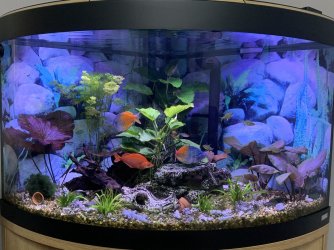TwoTankAmin
Fish Maniac
Ammonia can evaporate from water, but nitrite and nitrate cannot do this.
Live plants reduce nitrate in two ways. First, when they use ammonia (as Ammonium) they do not make nitrite and thus, no nitrate either. next, if the plants cannot get all the "food" they need from ammonium, they will use nitrate if it is available. But they do so less efficiently because they have to convert it back to ammonia to use it.
There has to be a cause for there to be nitrates in the container, they do not magically appear. The reality is there are basically two ways. One is they arrive in the tap water. The other would be ammonia arrives along with bacteria or else if the container never completely dries out there are bacteria living in it. That lost one is a stretch however.
It should actually be possible to figure this out. I cannot remember off the top of my head if you said the tank with nitrate issues was planted. If so, as plants grow it results in their using more ammonia, and possibly also nitrate, than they did going back in time. The other thing I know is that the least accurate test we do in our tanks for nitrogen related thing is the one for nitrate. How they usually work is that they convert the nitrate back to nitrite and read that. This is why is makes little sense during a cycle to test for nitrate during the high nitrite phase.
SeaChem's Nitrogen:
Live plants reduce nitrate in two ways. First, when they use ammonia (as Ammonium) they do not make nitrite and thus, no nitrate either. next, if the plants cannot get all the "food" they need from ammonium, they will use nitrate if it is available. But they do so less efficiently because they have to convert it back to ammonia to use it.
There has to be a cause for there to be nitrates in the container, they do not magically appear. The reality is there are basically two ways. One is they arrive in the tap water. The other would be ammonia arrives along with bacteria or else if the container never completely dries out there are bacteria living in it. That lost one is a stretch however.
It should actually be possible to figure this out. I cannot remember off the top of my head if you said the tank with nitrate issues was planted. If so, as plants grow it results in their using more ammonia, and possibly also nitrate, than they did going back in time. The other thing I know is that the least accurate test we do in our tanks for nitrogen related thing is the one for nitrate. How they usually work is that they convert the nitrate back to nitrite and read that. This is why is makes little sense during a cycle to test for nitrate during the high nitrite phase.
SeaChem's Nitrogen:
Flourish Nitrogen™ is a concentrated (15,000 mg/L) blend of nitrogen sources. It provides nitrogen in both the nitrate form and the plant–preferred ammonium form. However, no free ammonia is released because the ammonium in Flourish Nitrogen™ is complexed and unavailable until utilized by the plants. Ammonium becomes available after conversion of urea (carbamide). Flourish Nitrogen™ also provides nitrate for those plants that can readily utilize nitrate as well.


